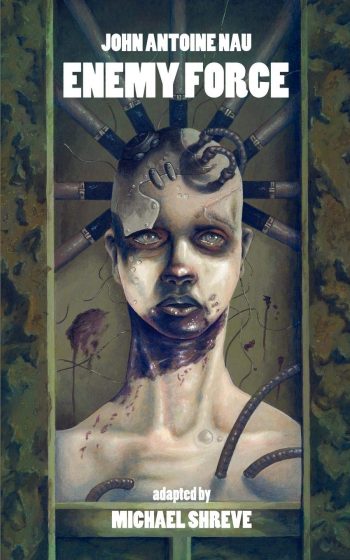 By JOHN ANTOINE NAU (Black Coat Press; 1902/2010)
By JOHN ANTOINE NAU (Black Coat Press; 1902/2010)
Here’s another case of a supposed “masterpiece” that I didn’t get. To be sure, this French freak-out was quite the ground-breaker when first published back in 1902, winning a prestigious literary award and proclaimed “The best one that we ever crowned” by one of the selectors, the renowned French novelist J.K. Huysmans. Now, however, a full 110 years later, John Antoine Nau’s ENEMY FORCE seems quite dull and uninvolving. The fault could be with the English translation—or, as the cover proclaims, “adaptation”—by Michael Shreve, who often seems puzzled by the text (note the parenthetical question marks that appear after certain odd words and phrases), but I don’t know about that.
The premise is a definite grabber: a man interred in an insane asylum finds his consciousness invaded and occasionally taken over by that of an apparent alien entity named Kmohoun, who among other outrages makes its host body molest a female inmate. The episodes in which Kmohoun telepathically communicates with the protagonist are appropriately strange and otherworldly, and culminate in a lovely bit of hallucinatory delirium set on Kmohoun’s world, a sequence that recalls THE HOUSE ON THE BORDERLAND in its visionary grandeur. Of course, whether Kmohoun, his world or even the protagonist’s actions in the here-and-now are “real” or just projections of a fractured psyche is left to the reader to decide for him/herself.
The unfortunate thing is that while Kmohoun’s intrusions are the driving force of the novel, and indeed provide the title, they don’t occur until 50 pages in—and after that only intermittently. In fact, by modern standards the “enemy force” would constitute a subplot.
The bulk of the narrative is taken up with boring conversations between the various eccentrics populating the insane asylum where most of the novel takes place and the asylum’s gruff overseers, which makes for a mighty rambling and unfocused narrative. Clearly things like narrative development and structure weren’t in vogue in early-1900s France, which is a shame, as ENEMY FORCE would have benefited from both.
